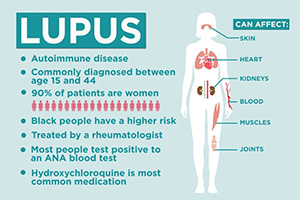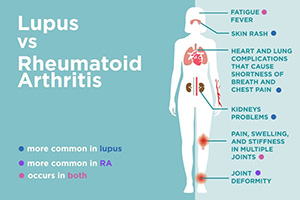
If you’ve been experiencing strange symptoms that you suspect to be an autoimmune disorder, you’ve probably been Googling like crazy to figure out what your pain and discomfort could mean. And what you may have been finding is that some autoimmune diseases—such as lupus and rheumatoid arthritis—are hard to differentiate.
So, how do you know if your symptoms are lupus or rheumatoid arthritis (RA)? Because there is no single blood or imaging test that can definitively diagnose one or the other, it can be hard to tell. But there are some discrepancies that can help you and your doctor figure out which tests would be most appropriate to figure out an accurate diagnosis.
In this post, we’ll define lupus and rheumatoid arthritis break down discrepancies between these two diseases so that you can be more informed when discussing your symptoms and testing options with your doctor.
What is Lupus?
Like most other autoimmune diseases, Lupus is a chronic disease in which the body’s immune system becomes hyperactive and begins to attack healthy tissue. Symptoms of this disease include but aren’t limited to:

While lupus symptoms can typically be vague and vary from person to person, the most common signs are rash and joint pain.
Those with the highest risk of lupus are women at the childbearing age (15 to 44 years old). In fact, women in general have the highest risk—they compromise about 90 percent of lupus patients, according to the Lupus Foundation of America.
However, other demographics can be affected by this disease. People of color, particularly African Americans, have a higher risk than white people. The disease also affects these populations differently. For example, Native American and black patients tend to have higher mortality rates than white people, while Hispanic and Asian patients have a lower risk of having lupus. Studies point to a genetic component in this disease, although researchers are investigating how socioeconomic factors play a role.
The cause of lupus is unknown. There is also no cure, but current treatments focus on improving quality of life by easing symptoms and minimizing flare-ups.
What is Rheumatoid Arthritis?
Rheumatoid arthritis (RA) is a chronic inflammatory disorder that can affect your joints, eyes, lungs, heart, and blood vessels. Like lupus, it’s an autoimmune disease, so it occurs when your immune system mistakenly attacks your healthy tissues. Symptoms of RA include:
Early RA tends to affect just your smaller joints first (fingers and toes) before spreading to the wrists, knees, ankles, elbows, hips and shoulders. Over time, RA can cause joints to shift out of place.
Almost half of patients with RA see the effects in non-joint areas as well, such as skin, lungs, heart, kidneys, nerves, lungs, and other places. Signs and symptoms vary in severity and usually go through phases of remission, similar to lupus flare ups.
Most people who develop this disease are diagnosed between the ages of 30 and 60. Women are more likely to develop RA as well. Other risk factors that can lead to more severe symptoms include smoking, environmental exposures such as asbestos or silica, and obesity.
Like lupus, doctors don’t know what triggers your body to develop RA—although research points to genetic components.
How Can I Tell the Difference?
Because the two diseases have such similar signs and symptoms, many have a hard time pinpointing an accurate diagnosis. For some, it’s taken years to find an accurate diagnosis.
However, there are some distinctions that can help you and your doctor more accurately diagnose. A few examples:

While the early stages of both diseases are hard to diagnose, doctors will normally look at exactly where you’re seeing the worst of your symptoms. It’s mostly about which symptoms stand out most and how those could more directly point to one or the other.
Rheumatologists will also look at a patient’s medical history and take a physical exam, as well as blood, urine, and imaging tests to make a diagnosis. Blood tests and imaging tests can be especially helpful, as they can go deeper to reveal some of the other discrepancies that point to one or the other.
At the end of the day, listen to your symptoms. Trust in what you feel and be vocal about it. The more information you can give your doctor the better they’ll be able to decide which tests will get you an accurate diagnosis quicker.
Clinical Trials for Lupus and Rheumatoid Arthritis
If you have already been diagnosed with lupus or rheumatoid arthritis, there may be a clinical trial in need of participants to find more effective treatments. Sign up to be alerted when a clinical trial is enrolling in your area that might be a good fit for you. We send you occasional updates on the state of clinical trials that might be important to you and we will alert you when we think we have found a hit.